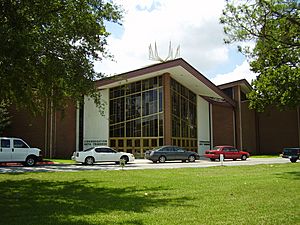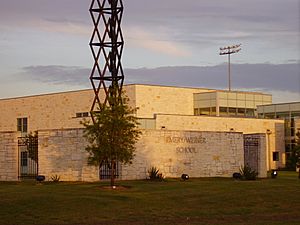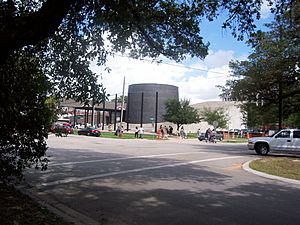History of the Jews in Houston facts for kids
The Jewish community of Houston, Texas, has grown and thrived since the 1800s. As of 2008, Jewish people lived in many Houston neighborhoods. Meyerland is a main center for the Jewish community in the area.
Contents
History of Jewish People in Houston
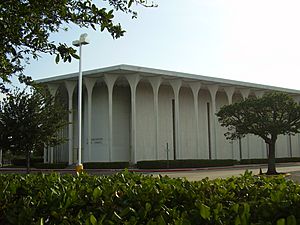
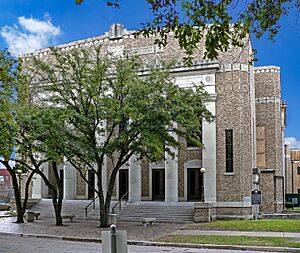
Before 1880, Houston had a smaller Jewish population compared to Galveston Island. Galveston was then the main cultural center of Texas. In 1844, the first Jewish cemetery in Houston was created. By 1850, there were 17 Jewish adults in Houston. In 1854, the Orthodox Beth Israel Congregation opened. It was in a house changed into a synagogue.
By 1860, the number of Jewish adults grew to 68, and there were 40 Jewish children. In the 1800s, Jewish people first lived in the First and Second wards. Later, they settled in the Third Ward.
Congregation Beth Israel first started in a wooden building on LaBranch Street. This was near the Third Ward settlement. In the 1800s, Jewish settlers from Eastern Europe moved to the Franklin and Navigation area in the Fifth Ward. They also moved to the area around Washington and Houston street in the Sixth Ward. By 1987, these historic areas no longer had many Jewish residents.
Starting in 1880, many Eastern European Jews moved to Houston. They settled in wards two and three. They mixed with German Jews, which was different from how Eastern European Jews lived on the East Coast. Around that time, two Orthodox Jewish synagogues were founded: the Russian-Polish Adath Yeshurun and the Dorshe Tov synagogue. Adath Yeshurun later joined with Congregation Adath Yeshurun in 1891.
The Galveston Plan was an early 1900s idea. It sent Jewish immigrants from crowded East Coast cities to less crowded areas. Many Jews came to Houston because of this plan. In 1903, a Zionist organization opened in Houston. Zionism is a movement that supports the development and protection of a Jewish nation in what is now Israel. In 1908, The Jewish Herald-Voice newspaper started. In 1915, a Jewish Workmen's Circle opened.
In the 1920s, Jewish families began to settle in the Washington Terrace and later the Riverside Terrace areas. These are in the current Third Ward. Many Jewish places, like synagogues, stayed there until the late 1950s. Temple Beth Israel moved to Riverside Terrace in 1925. Temple Beth Yeshurun opened in the same area in 1945. Jewish families moved to Riverside Terrace in the 1930s because they were not allowed to settle in River Oaks. Riverside Terrace was once a very wealthy area.
Around 1874, Beth Israel became a Reform Judaism synagogue. Reform Judaism is a modern movement that adapts Jewish traditions. Congregation Beth El was founded in 1924. It was the first Conservative Judaism synagogue in Houston. Conservative Judaism is a middle ground between Orthodox and Reform. In 1925, it used the old Beth Israel building. Adath Yeshurun later joined with Beth El and became Congregation Beth Yeshurun. In the 1930s, many Jewish refugees from Germany moved to Houston. In 1943, Temple Beth Israel said that people who supported Zionist ideas could not be members. So, Emanu-El was formed by those who disagreed. After World War II, more Jewish immigrants from Eastern Europe came to Houston.
By the 1950s, many Jewish families moved to Southwest Houston. Jewish organizations also moved there. The first neighborhoods to welcome Jewish people were along North Braeswood and South Braeswood. Later, Meyerland also became a Jewish community. From 1955 to about 1987, the Jewish population in Houston grew by 300%. By the 1970s, Jews moved to Fondren Southwest and the Memorial and Spring Branch areas. By 1987, there were about 42,000 Jewish people in Greater Houston. They lived in many parts of the area.
In 2017, Hurricane Harvey caused damage to the Meyerland area. This included the three largest synagogues, the Jewish community center, several Jewish private schools, and the Jewish senior home.
In 2024, the Jewish Federation of Greater Houston spoke out against some suggested changes to Texas public elementary school lessons. They said these changes favored Christianity and were unfair to Judaism.
Jewish Population in Houston
In 1987, there were about 42,000 Jewish people in Greater Houston. About 2.5% of the City of Houston was Jewish. In 2001, there were 47,000 Jewish people in the Houston area. The Jewish Federation of Greater Houston counted again in 2016, finding 51,000 Jewish people living in Greater Houston.
Jewish people in Houston came from all over the United States, Israel, Mexico, Russia, and other places. Because the Jewish population grew quickly between 1955 and 1987, many Jewish people counted in 1987 were new to Houston.
Jewish Communities in Houston
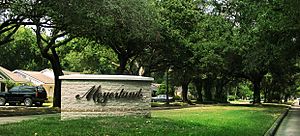
In 1987, Jewish people lived in many Houston communities. In 2008, it was noted that Houston has Jewish people spread out. The city's "hub of Jewish life" is the Meyerland community. Southwest Houston is considered the "Jewish core of town." Synagogues have also opened in Clear Lake City, Kingwood, and The Woodlands. Clear Lake City has also seen more Jewish families move there in the 2010s.
Synagogues in Houston
A synagogue is a Jewish house of worship and study. In 1987, there were over 20 synagogues in Greater Houston. As of 2016, there were over 40 synagogues in Greater Houston.
In 1987, Congregation Beth Yeshurun (Conservative Judaism) and the Reform Judaism congregations Beth Israel and Emanu-El were the largest synagogues in Houston. The Orthodox Judaism community includes several congregations. Orthodox Judaism follows Jewish law very strictly. These include Chabad Lubavitch Center of Houston, the Sephardic Beth Rambam Congregation, Young Israel of Houston, Meyerland Minyan, and the Sephardic synagogue Torah Vachesed.
The United Orthodox Synagogues congregation formed in 1961. It was a joining of three synagogues. It has been in the same building near Meyerland since it was built that year. The building flooded during Memorial Day in 2015 and Tax Day in 2016. After Hurricane Harvey damaged the buildings in 2017, the congregation decided to tear down the main sanctuary and school building. They would use the Freedman Hall building for worship for a while. As of 2018, the congregation has 300 people.
Congregation Emanu El Temple was built in 1949. It uses a Mid-Century Modern architectural style.
By 2011, the Shul of Bellaire, a Chabad-Lubavitch center, was started in January 2011. It was the first Chabad-Lubavitch center in Bellaire.
Congregation Or Ami is in Westchase, in west Houston, near Greater Katy. As of 2018, the rabbi is Gideon Estes.
There are two Jewish places of worship in The Woodlands. Congregation Beth Shalom started around 1984. As of 2004, it had about 130 families and belongs to Reform Judaism. Chabad of The Woodlands was started in 2011. It is part of the worldwide Chabad Lubavitch movement. It offers traditional services to modern Jewish families. Chabad of The Woodlands started the yearly Chanukah on Market Street celebration. It also opened the first Jewish preschool in the area.
Chabad Pearland Jewish Center is the first Jewish center of worship in Pearland. It was started in 2009. It also serves Alvin and Friendswood.
Temple Beth Tikvah, the Jewish Center of Clear Lake, is in the Clear Lake area.
There are also synagogues in Humble and Victoria.
List of Synagogues:
- Congregation Beth Rambam (Sephardic)
- Torah Vachesed (Sephardic)
- Hemish (Hasidic)
- Young Israel of Houston
- Chabad Lubavitch Center
- Chabad at Rice
- Chabad at the Medical Center
- Chabad Lubavitch of West Houston - CHAI Learning Center
- Chabad of Uptown
- Congregation Emanu El
- Congregation Beth Israel of Houston
- Congregation Beth El
- Congregation Shma Koleinu
- Houston Congregation for Reform Judaism
- Temple Beth Tikvah
- Temple Sinai
- Congregation Beth Yeshurun (Houston)
- Congregation Brith Shalom
- Congregation Or Ami
- Congregation Shaar Hashalom
- The Shul of Bellaire
- Bellaire Jewish Center
- United Orthodox Synagogues "UOS"
- Keshet Houston
Jewish Education in Houston
Houston has several Jewish elementary schools. The Conservative Judaism elementary school is the William S. Malev School at Beth Yeshurun. The Reform Judaism elementary school is the Irvin M. Shlenker School at Beth Israel. Chabad Lubavitch supports the Torah Day School of Houston.
Emery/Weiner School is a Jewish secondary school in Houston. The Robert M. Beren Academy is a Modern Orthodox primary and secondary school. This school, once called Hebrew Academy, is an independent Jewish school.
Because many Jewish students attended, Bellaire High School was once nicknamed "Hebrew High."
Jewish Community and Work
Around 1987, most Jewish people in Houston worked in professional jobs. Many also worked in business, including retail and businesses that support retail.
Mickey Leland started the Youth Kibbutz Internship. This program sends ten minority children to Israel during the summer. It was created to improve relationships between African-American and Jewish communities.
Jewish Media in Houston
The Jewish Herald-Voice is a Jewish community newspaper. Its main office is in Houston.
Jewish Institutions in Houston
The Jewish Federation of Greater Houston has its main office in Houston.
The Jewish Community Center (JCC) has a main location on South Braeswood Boulevard. It also has a branch in the Memorial area of west Houston. In the Fondren area, it runs the Bertha Alyce Early Childhood Center. The Jewish Federation of Greater Houston's offices are next to the main JCC building. The Seven Acres Jewish Geriatric Center helps elderly Jewish people.
The Houston Holocaust Museum opened in 1993. It teaches about the Holocaust, a terrible time in history when millions of Jews were killed.
Other important Jewish groups and places include Jewish Family Service, Hebrew Free Loan Association, Chabad Lubavitch Center, Hillel Foundation of Greater Houston, and many Jewish day schools.
Rice University started the Houston Jewish History Archive around 2017. This archive collects and saves Jewish history. Many items were saved after Hurricane Harvey hit Houston in 2017. As of 2018, people from Rice University were collecting items for the center.
Notable Jewish Persons from Houston
- Max Apple (author)
- David Biespiel (author)
- Rosellen Brown (author)
- Aaron Farfel (leader at University of Houston System)
- Billy Goldberg (politician, president of the Texas Democratic Party)
- Mark Goldberg (politician, City Councilmember of Houston)
- Norman Hackerman (president of the University of Texas at Austin and Rice University)
- Charles Hoffman (reporter for the Jerusalem Post)
- Jeffrey Hoffman (first Jewish astronaut)
- Fredell Lack (violinist)
- Rabbi Shimon Lazaroff (Director of Chabad Lubavitch of Texas)
- David Leebron (President of Rice University)
- Julia Wolf Mazow (author)
- Joseph Melnick (scientist at Baylor College of Medicine)
- Alfred R. Neumann (founding chancellor of University of Houston–Clear Lake)
- Judith Resnik (astronaut, died in the Space Shuttle Challenger disaster)
- Marvin Zindler (journalist)
- David Berg, Attorney and Author (attorney and author)
- Ian Hernandez (community leader and philanthropist)



